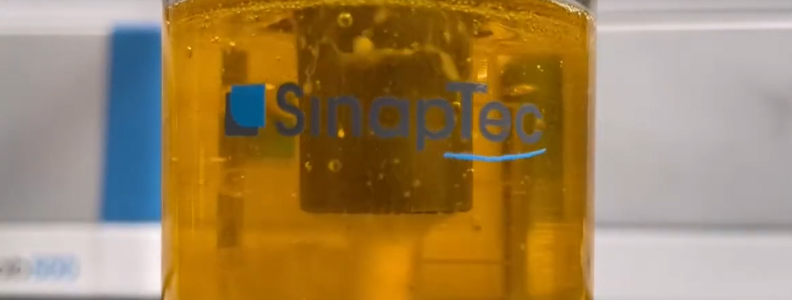
Degassing viscous liquids is a crucial step for many industries to ensure the quality and stability of final products. In this context, the use of ultrasound to carry out this operation is a technique that is generating growing interest. A technique we absolutely had to share with you—based on tests conducted at SinapTec, your ultrasound specialist!
And for good reason: as you may already know, traditional degassing methods can be time-consuming and energy-intensive, whereas ultrasound degassing helps optimize this operation while reducing certain constraints. This article is the perfect opportunity to explore in detail how ultrasonic degassing works and its advantages—before inviting you to watch the video we created for the occasion.
What is Industrial Degassing and Why Is It So Important?
Industrial degassing involves removing both free and dissolved gases present in a liquid. In industrial processes, it is critically important for several reasons. First, trapped gas bubbles can lead to defects in final products, especially in fields where material purity and stability are essential—such as in the production of polymers, adhesives, or resins. Additionally, dissolved gases can impact the mechanical properties, shelf life, and environmental resistance of products.
With viscous liquids, degassing is even more challenging because high viscosity slows down the rise of gas bubbles to the surface. This phenomenon can cause bubbles to accumulate in the product, compromising not only its quality but also the efficiency of the manufacturing process. Therefore, it is essential to choose an effective degassing method to ensure the final product’s quality while adhering to production standards. Conventional industrial degassing methods rely on mechanical or thermal means that have notable limitations, which we will outline below.
How Ultrasound Facilitates Degassing of Viscous Liquids
Using ultrasound to degas a liquid is based on a phenomenon known as cavitation. When high-power ultrasound waves pass through a liquid, they create rapid pressure variations, forming microbubbles of cavitation. These microbubbles expand and collapse rapidly, generating intense mechanical and thermal effects on a very localized scale. This process accelerates the coalescence of dissolved gas bubbles, meaning it helps them merge into larger bubbles that can rise to the surface more easily.
In viscous liquids, this method is particularly effective because the cavitation produced by ultrasound locally reduces the viscosity of the liquid, making it easier for gas bubbles to migrate. Since viscosity is a key factor that slows bubble ascent in such liquids, temporarily lowering it speeds up the release of dissolved gas.
It is also important to note that this process does not cause a significant increase in the overall temperature of the liquid. While cavitation creates localized heat points, they dissipate quickly and do not significantly affect the liquid’s temperature. In our tests, we observed a temperature variation limited to 5°C—a perfectly acceptable result in industrial production, where maintaining a stable temperature is often critical to preserving product properties.
Industrial Degassing Solutions: Comparing Methods
Let’s now compare the ultrasonic method with more conventional industrial degassing techniques such as mechanical or thermal degassing to better understand the advantages of this technology:
🔹Mechanical degassing relies on physical agitation, which may not be effective for viscous liquids, where stirring is less efficient at releasing trapped gas bubbles. Additionally, this method can be time-consuming, slowing down production rates and increasing energy and equipment maintenance costs.
🔹Thermal degassing works by heating the liquid to reduce the solubility of dissolved gases, making them easier to release. However, this approach has major drawbacks. Raising the temperature can alter the liquid’s properties—often undesirable in processes requiring product stability. The energy cost is also high, particularly for large-scale production. Furthermore, in viscous liquids, simply applying heat often isn’t enough to facilitate gas bubble removal.
🔹Ultrasound, on the other hand, offers a faster and more energy-efficient degassing solution. By generating localized cavitation effects, it enables the release of dissolved gases without requiring large amounts of energy or time. Moreover, by avoiding excessive temperature increases, ultrasound preserves the original properties of the product and offers a solution that is more compatible with industrial production constraints.
In Conclusion
While some technical improvements are still possible, ultrasonic degassing stands out as a promising method for the industry. It enables faster degassing while maintaining product stability.
We are very excited to share the result of a test in our laboratory regarding ultrasonic degassing. The innovation at the heart of your applications thanks to our new range of ultrasonic board.
Here is the result in video:
Need a tailored solution for your liquids?
Contact our experts to discuss your specific needs—we’ll help you design a high-performance, reliable degassing system perfectly suited to your environment.


